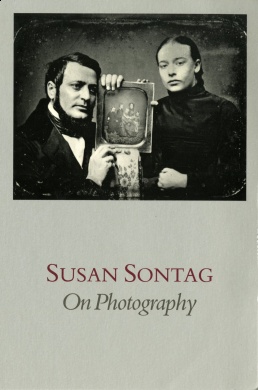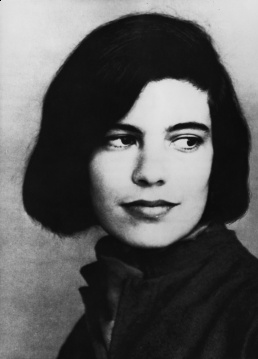Difference between revisions of "Susan Sontag"
| Line 1: | Line 1: | ||
[[Image:Susan_Sontag_1964_by_Paul_Popper.jpg|thumb|258px|Susan Sontag, c1964. Photo by Paul Popper.]] | [[Image:Susan_Sontag_1964_by_Paul_Popper.jpg|thumb|258px|Susan Sontag, c1964. Photo by Paul Popper.]] | ||
| − | '''Susan Sontag''' (January | + | '''Susan Sontag''' (born Susan Rosenblatt, 16 January 1933 – 28 December 2004) was an American writer and filmmaker, novelist, writer of screenplays, professor, literary icon, and political activist. |
==Life and work== | ==Life and work== | ||
Revision as of 17:57, 30 August 2014
Susan Sontag (born Susan Rosenblatt, 16 January 1933 – 28 December 2004) was an American writer and filmmaker, novelist, writer of screenplays, professor, literary icon, and political activist.
Contents
Life and work
Susan Sontag took her B.A. at the University of Chicago and her M.A. at Radcliffe College. She also studied at Oxford University. Through her essays, which have been published in magazines and journals across the country, Sontag established a reputation as a critic of modern culture. Probably she will be remembered for her contribution to the theory of aesthetics.
Beginning with the publication of her 1964 essay Notes on 'Camp' , Sontag became an international cultural and intellectual celebrity. Sontag was active in writing and speaking about, or travelling to, areas of conflict, including during the Vietnam War and the Siege of Sarajevo. She wrote extensively about photography, culture and media, AIDS and illness, human rights, and communism and leftist ideology. Her often provocative essays and speeches sometimes drew criticism. The New York Review of Books called her "one of the most influential critics of her generation" [1].
Her place of authority in the contemporary world of art criticism was confirmed with the publication, in 1976, of a series of essays - On Photography. In it she writes, "The photographer, now charging real beasts, beleaguered and too rare to kill. Guns have metamorphosed into cameras in this earnest comedy, the ecological safari, because nature has ceased to be what it always had been - what people needed protection from. Now nature - tamed, endangered, mortal - needs to be protected from people. When we are afraid we shoot. But when we are nostalgic, we take pictures." (1977: 15).
In her best-known work, Against Interpretation (1966), Sontag enunciates a theory of art based upon a reliance on the senses and not on the intellect. By her nonfiction writes Sontag demonstrate her ability to address current social and political realities with the same incisiveness that she approaches questions of art. In "Women's Beauty", which she first published in Vogue magazine in 1975, Sontag provides us with a feminist interpretation of the uses and misuses of "beauty" throughout history. This essay also serves as a model for those who would question a variety of accepted moral, ethical, and social standards.
Works

Monographs
- On Photography, 1977. [2] [3]
- Sobre la fotografía (Spanish, trans. Carlos Gardini), 1981
- Illness as Metaphor, 1978
- AIDS and Its Metaphors (a continuation of Illness as Metaphor), 1988
- Regarding the Pain of Others, 2003
Novels
- The Benefactor, 1964
- Death Kit, 1967
- The Volcano Lover, 1992
- In America, 2000
Essay collections
- Against Interpretation and Other Essays, New York: Farrar, Straus & Giroux, 1966. Excerpts.
- Styles of Radical Will, 1969.
- with Peter Hujar, Portraits in life and death, Da Capo Press, 1976.
- Under the Sign of Saturn, 1980.
- A Susan Sontag Reader, ed. Elizabeth Hardwick, London, 1983.
- Where the Stress Falls, 2001.
- At the Same Time: Essays & Speeches, 2007.
Articles, papers, chapters, reviews
- "Notes on Camp", Partisan Review, 1964; repr. in Camp: Queer Aesthetics and the Performing Subject: A Reader, 1964, pp 53-65.
- "Film and Theatre", The Tulane Drama Review 11:1 (Autumn 1966), pp 24-37.
- "A Note on Bunraku", The Threepenny Review 16 (1984).
- "In Conclusion...", East-West Film Journal 2:1 (December 1987), pp 93-106.
- "The Decay of Cinema", New York Times, 1996.
- "Why are we in Kosovo?", New York Times Magazine, 2 May 1999.
- "A Photograph is not an Opinion. Or is it?", Women, 1999.
- "Looking at War", The New Yorker, 9 Dec 2002, pp 82-98.
- "Regarding the torture of others", New York Times, 23 May 2004, p 24.
- "At the same time... (the novelist and moral reasoning)", English Studies in Africa 48:1 (2005), pp 5-17.
- "An argument about beauty", Dædalus (Fall 2005), pp 208-213.
Bibliographies
- Leland A. Poague, Kathy A. Parsons, Susan Sontag: An Annotated Bibliography, 1948-1992, Modern Critics and Critical Studies, vol. 22, Garland Reference Library of the Humanities, Vol. 1065, 2000.
- in Chris Murray (ed.), Key Writers on Art: The Twentieth Century, Routledge, 2002.
Interviews
- Evans Chan, "Against Postmodernism, etcetera--A Conversation with Susan Sontag", Postmodern Culture, 2001
- "Art and Consciousness" (Susan Sontag interviewed by Bonnie Marranca and Gautam Dasgupta), Performing Arts Journal", 80 (2005):1–9.
Literature
- Papers and articles
- Toback, James, "Whatever You'd like Susan Sontag to think, She doesn't", Esquire magazine, no. 70 (1968):58-61.
- Sohnya Sayres, "Susan Sontag and the Practice of Modernism", American Literary History, Vol. 1, No. 3. (Autumn, 1989):593-611
- Steven Drukman, "Notes on Fornes (with apologies to Susan Sontag)", American Theatre, 17.7 (2000):36
- Barbara Clow, "Who's Afraid of Susan Sontag? or, the Myths and Metaphors of Cancer Reconsidered", Social History of Medicine, Vol. 14, no. 2, 2001:293-312
- Sarah Parsons, "Sontag’s Lament: Emotion, Ethics, and Photography", Photography & Culture, vol. 2, no. 3, November 2009: 289–302
